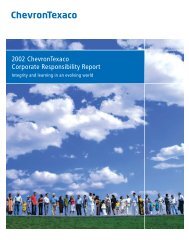Next* Magazine, Issue 4 - Chevron
Next* Magazine, Issue 4 - Chevron
Next* Magazine, Issue 4 - Chevron
- No tags were found...
Create successful ePaper yourself
Turn your PDF publications into a flip-book with our unique Google optimized e-Paper software.
Here and NowNew oil supplies from the fourth dimensionGeophysical reservoir surveillance provides clues to tracking hidden oiland gas—and the benefits promise to be hugeWelcome to the fourth dimension, anunderground frontier of time andspace where <strong>Chevron</strong>’s earth detectives aremoving beyond their usual tough job of findinghidden energy resources to take on aneven tougher job: tracking the migration of oilthrough giant rock reservoirs.What’s learned from this work, knownComparing 3-D surveys of the same areais buried 15,000 feet (4,572 m) undergroundas geophysical reservoir surveillance (GRS),a few years apart allows geophysicists tobeneath 3,000 feet (914 m) of ocean?has the potential to add billions of barrels ofsee these changes through time—seismic’sComparing your seismic survey to anotheroil and trillions of cubic feet of natural gasfourth dimension—helping companies fine-from a few years back, could you map differ-to the world’s energy reserves, said Larrytune their follow-up development work asences in air conditioning efficiency from oneSydora, leader of the company’s GRS team.fields are depleted.building to the next?Ultimately, GRS will help <strong>Chevron</strong> manage itsassets as efficiently as possible.“The technology is evolutionary, but theimpact could be revolutionary,” said SteveHow to be precise, twiceThe dimension of timeGRS employs several kinds of tools. But themost powerful is four dimensional, or time-Smith, <strong>Chevron</strong> manager of deepwater producingassets in the Gulf of Mexico.Enjoying hard problemsEmerging over the past 20 years, GRSdoesn’t work everywhere because somereservoirs don’t readily reveal their secretswith acoustics. For 4-D to work, surveys mustlapse 4-D seismic surveying, based on theLooking out his office window in downtowntry to hit precisely the same places twice—notconcept that two surveys are better than one.Said Bernard Regel, deepwater geologist with<strong>Chevron</strong>’s U.S. Gulf of Mexico operations:“The more pieces of information we have, themore puzzles we can solve in the earth.”Three-dimensional seismic testing shootsshock waves into the earth’s crust, then readsthe bounced-back waves to reveal targetsfor exploratory drilling. But every discoveredreservoir changes as resources flow out.Pressures drop. Groundwater moves. Layerssettle. The acoustic properties of the rockschange, creating opportunities to gather newclues as production proceeds.Houston, Texas, Mike Allison, <strong>Chevron</strong>’s headof reservoir management, applauds the contributionsof GRS but also puts the situation inperspective.“You want to be sure the technology willwork as planned to generate new informationyou can act on,” he said. “Better pictures ofwhat’s down there can produce potentiallyrevolutionary results.”Try to imagine, he suggested, usingseismic waves to map the floor plans, wallsand ventilation systems within all the bigbuildings in the metropolitan skyline. What ifsomething the size and shape of that skylineeasy in deep water. “Repeatability is the keything in 4-D,” said Regel.As options mature, 4-D technology hasalready proved itself or shown great promisein fields operated by various companiesin the Gulf of Mexico, Norway’s North Sea,Brazil’s Campos Basin and other areas.<strong>Chevron</strong> is planning global deployments ofthe technology.“In my view, GRS has a very bright future,especially in Africa,” said Pete Mitchell,geophysical team leader for the company’sSouthern Africa operations. He has highexpectations for a planned 4-D survey ofPHOTO: ATLI MAR HAFSTEINSSON/NORDIC PHOTOS/GETTY IMAGES8 | <strong>Next*</strong>
















